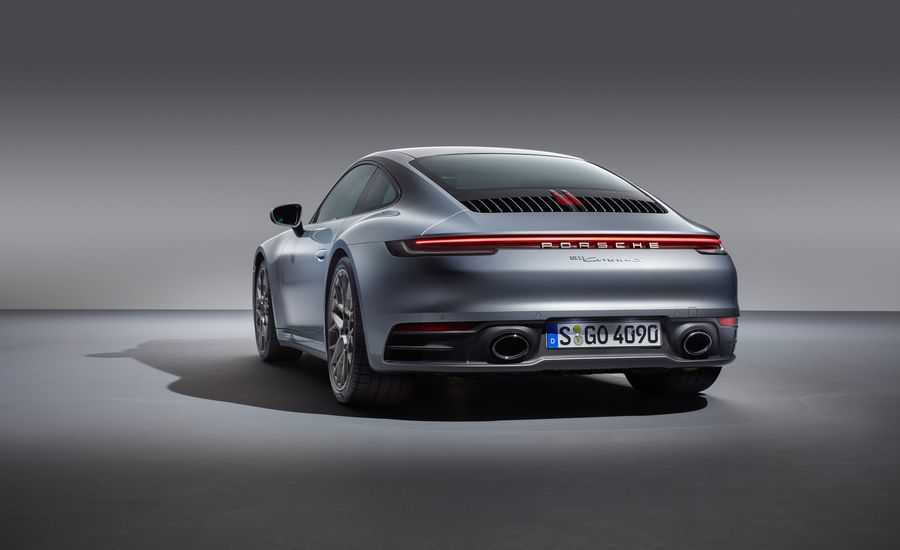The 2020 Porsche 911 Is Evolved Yet Easily Identifiable

This won't be surprising, but Porsche doesn't take any changes lightly, particularly to its flagship 911 sports car. But something that reminds us all over again just how carefully every piece of this rear-engined puzzle is considered is hearing the man in charge of 911 development since the 2005 997 generation, August Achleitner, describe with a combination of anguish, reverence, and consternation the decision to remove the capability for manual shifting using the shift lever of the PDK automatic on this new 992-generation car. Before you start circling the Porsche-club wagons, there's still a manual mode controlled by steering-wheel paddles; it's just that the lever itself is now a little joystick toggle, just like in the 918 Spyder supercar. And it doesn't strike us as a terribly big deal.
But the 911 is Porsche, so we understand the desire to proceed with care. This 992-generation model—which grows wider, boasts incremental power gains, and offers a host of new technology—is launching with the 2020 S and 4S models, which make their debut at the Los Angeles auto show and go on sale first, hitting the U.S. market in the summer of 2019. Initially they'll come only with the joystick shifter and the new eight-speed dual-clutch automatic transmission, but the seven-speed manual returns later in 2019 as the inevitable tide of additional 911 variants starts to roll out.
Heritage Design
Although we rode along with engineers in the new model a few months back, this is the first time we're seeing the new, fully uncamouflaged design. While the 911 is a defining example in automotive evolution, there are a few identifiers on this new model that make it easy to spot. In a throwback to the original, a design cue that carried through more than three decades to the 1999 996 model, the frunklid is squared off, with a slightly recessed center section defined by two prominent creases. In back, there's a Panamera-esque full-width light bar. The center brake light is now vertical, integrated into the slats on the engine cover. New on-demand exterior door handles stay flush to the body and pop out when needed. Dimensionally, the 992 is 0.8 inch longer on an unchanged 96.5-inch wheelbase. Also unchanged are interior and cargo volume. But all versions of the new car inherit the wide-body rear end from today's all-wheel-drive and GTS variants. The new car also grows 1.8 inches in width at the front end to accommodate nearly the same stretch of front track width.
The S models make 443 horsepower, effectively notching up to former GTS-grade power. Porsche confuses the matter slightly by rating this new engine at 443 horsepower rather than the 991.2 GTS's 450 hp—with a slightly evolved version of the twin-turbo 3.0-liter flat-six. And it makes that additional power with no increase to boost pressure, but rather by other changes, such as a larger intercooler, a compression ratio increased from 10.0:1 to 10.5:1, and a switch to piezo injectors. Euro-spec models also add a particulate filter to meet tightening emissions standards, which we're told has a muffling effect. U.S. cars, which won't get it, will be slightly louder.
With the optional Sport Chrono package and the launch-control functionality it adds, Porsche says that the new S model reaches 60 mph 0.4 second quicker, which, according to our testing of the current model, means the new S could be in the high-two-second range. The 4S is a tenth quicker still. At 191 mph, top speed for the S is a single mph higher—2 mph higher at 190 mph for the 4S—and achieved in sixth gear.
Source: https://www.caranddriver.com
Tags :
Previous Story
- Bangladeshi Uber driver found guilty over passenger's death...
- DBA to strengthen country’s capital market
- Dhaka stocks inch down as investors remain cautious
- Rumors suggest Huawei could beat Samsung to an...
- BSEC bars KPCL share transfers, sales by sponsors,...
- Best Cyber Monday Deals: Switch, Red Dead 2,...
- Bangladesh saves its favourite fish
- China's Dezhou signs MoUs with Bangladesh to boost...